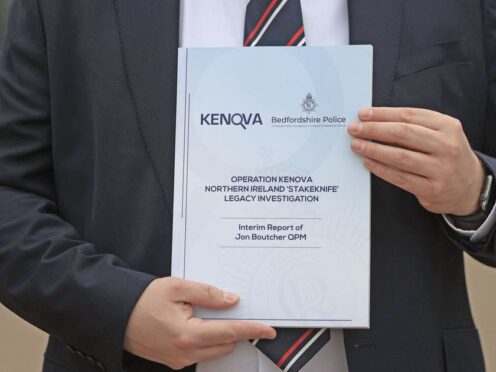
More lives were probably lost than saved through the British Army’s operation of its top agent inside the IRA’s internal security unit during the Troubles, a major independent investigation has found.
The interim findings of Operation Kenova examined 101 murders and abductions linked to the IRA unit responsible for interrogating and torturing people suspected of passing information to the security forces during the conflict.
Operation Kenova, which was undertaken by Bedfordshire Police and ran for seven years at a cost of approximately £40 million, examined the role of the Army’s prized agent embedded in the heart of the IRA’s Internal Security Unit (ISU), an individual known as Stakeknife.

The agent Stakeknife was widely believed to be west Belfast man Freddie Scappaticci, who was 77 when he died last year.
The Operatio Kenova report stops short of confirming Scappaticci as Stakeknife.
However, it says that the Kenova team had passed “strong evidence of very serious criminality” by Scappaticci to prosecutors in Northern Ireland prior to his death.
The report also dismisses rumours that Scappaticci might still be alive.
Among 10 recommendations in the 208 page report, is a call for the UK authorities to review the application of the Neither Confirm Nor Deny policy (NCND) that currently prevents the identification of agents involved in many historical Troubles cases.

It links the “dogmatic” policy with a failure to secure prosecutions in some Troubles cases.
The report also calls on the UK and the IRA to apologies to bereaved families and victims of the ISU, the security forces for failings amid a “maverick” culture for handling agents and intelligence; and the IRA for the abduction, murder and torture of people it suspected of being agents, and linked campaigns of intimidation against their families.
The Kenova investigation was originally headed up by former Bedfordshire Police chief constable Jon Boutcher but he left the position to take up the role of chief constable of the Police Service of Northern Ireland (PSNI).
Last week the Public Prosecution Service in Northern Ireland announced that no prosecutions would be pursued after consideration of the last batch of files from the investigation.
Some 32 people, including former police, former military personnel and people linked with the IRA, were considered for prosecution on a range of charges from murder and abduction to misconduct in public office and perjury.
However, the PPS found there was insufficient evidence to pursue cases.
In the report, Mr Boutcher said “various myths and erroneous stories” have built up around Stakeknife.
He said those within the security forces are defensive about the agent, viewing through “rose tinted spectacles” and claiming Stakeknife potentially saved “hundreds of lives” while people outside the establishment overestimate the number of crimes the agent was responsible for.
Mr Boutcher said the suggestion Stakeknife saved countless lives was not grounded in fact.
“In reality the claims are inherently implausible and should ring alarm bells: any serious security and intelligence professional hearing an agent being likened to ‘the goose that laid the golden eggs’, as Stakeknife was, should be on alert because the comparison is rooted in fables and fairy tales,” he said.
“Stakeknife was undoubtedly a valuable asset who provided high quality intelligence about PIRA at considerable risk to himself, albeit that this intelligence was not always passed on or acted upon and, if more of it had been, he could not have remained in place as long as he did.”
Mr Boutcher said Kenova reviewed around 90% of intelligence reports attributed to Stakeknife.
He said he estimated the number of lives saved as a result of intelligence provided by Stakeknife was in the high single figures or low double figures and “nowhere near” the hundreds that have been claimed.
“Crucially this is not a net estimate because it does not take account of the lives lost as a consequence of Stakeknife’s continued operation as an agent,” he added.
“And, from what I have seen, I think it probable that this resulted in more lives being lost than saved.
“Furthermore, there were undoubtedly occasions when Stakeknife ignored his handlers, acted outside his tasking and did things he should not have done and when very serious risks were run.”

Enjoy the convenience of having The Sunday Post delivered as a digital ePaper straight to your smartphone, tablet or computer.
Subscribe for only £5.49 a month and enjoy all the benefits of the printed paper as a digital replica.
Subscribe